Target Markets, Positioning and Segmentation
You started by identifying consumer needs, wants and demands. The next step is how you ensure that you are addressing the right target group with an offer matching their needs.
The STP approach is useful here
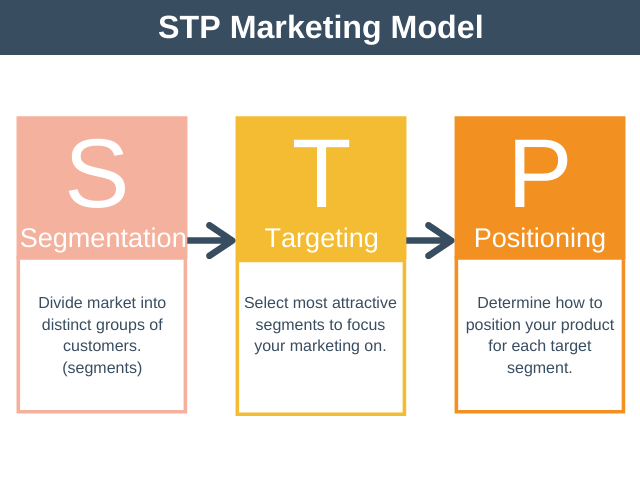
Not everyone likes the same cereal, restaurant, university, or movie. Marketers therefore identify distinct segments of buyers by identifying demographic, psychographic, and behavioral differences between them. They then decide which segment(s) present the greatest opportunities. For each of these target markets, the firm develops a market offering that it positions in target buyers’ minds as delivering some key benefit(s). Porsche targets buyers who seek pleasure and excitement in driving and want to make a statement about their wheels.
SEGMENTATION
Segmentation means to divide the marketplace into parts, or segments, which are definable, accessible, actionable, and profitable and have a growth potential. In other words, a company would find it impossible to target the entire market, because of time, cost and effort restrictions

Market segmentation is a process of dividing the entire market population into multiple meaningful segments based on marketing variables like demographics (age, gender etc), geographic, psychographics (lifestyle, behavior) etc. Market segmentation in marketing is identifying a set of homogeneous segments having similar needs, properties & demands which can be used by a company to sell their product/service more effectively.
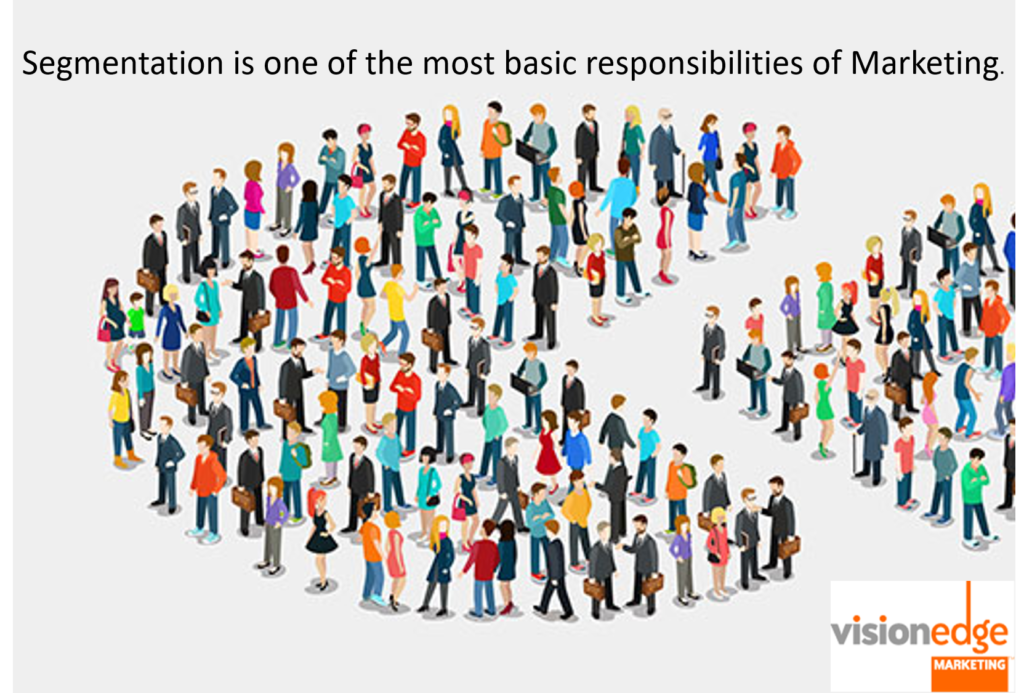
Market segmentation is an important aspect for any business as it helps them slice the market into smaller groups or segments, which can then be identified based on their needs and can be catered to. Market segmentation reduces the population in the market and gives a much more addressable audience rather than giving random groups of people. Having similar groups would enable companies to be more focused in terms of their product offerings, product differentiation strategies, marketing strategies, pricing strategies etc. This would help companies mitigate unnecessary risks, reduce costs, target customers better, have better retention and generate more profits. Hence, segmenting the entire population of market is essentially critical and important for any business to prosper.
Most used Segmentation types
The most important variables in market segmentation are based on demographics, geographic, psychographics & behavioural. These are explained in detail below:
1. Demographic Segmentation:
Slicing the market on criteria based on demographics like age, gender, income, family members, educational qualification, socio-economic status etc, is called demographic segmentation.
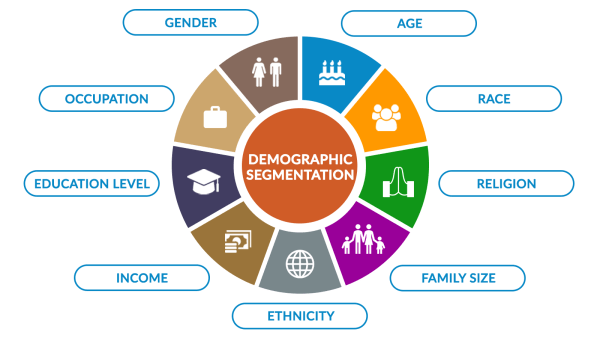
This type of market segmentation helps in profiling the customers based on demographic parameters & help to form homogeneous groups.
You can see demographic segmentation at play when you walk into any grocery store. Depending on where you live, you’ll see all kinds of different people.
Peek into their carts and you’ll get a glimpse of who they are: The young mother with a toddler strapped to her back may haul away Annie’s Organic Mac and Cheese, strawberries, and baby wipes. The overeager college student might grab a mountain of candy and soda for an all-night cram session.
Every person’s lifestyle demands a different set of items.
This concept applies to consumers of every kind. That’s why everyone who sells a product needs to know who they’re selling to and what those people like.
2. Geographic Segmentation:
When a population is divided on the basis on geographies i.e. country, state, city, village, region, postal code etc, it is referred to as geographic segmentation. This market segmentation type helps form clusters based on location, topography, location etc.

People who live in densely populated cities will have different wants and needs than those living in rural communities. A Home Depot in New York City might focus its Garden Center offerings on products and plants that do well in a patio or porch setting. Meanwhile, a Home Depot in Iowa might instead focus on stocking up with plenty of seeds, starter plants, and other products needed for large gardens and fields. Home Depot’s target audience is also affected by factors such as the average household income of the area, the distance people are used to driving to get to a store, and the local design and decor preferences.
A winter-gear brand like Rossignol would waste its money marketing to those who live in Florida. It would do much better in states that see a large amount of snow, like Alaska, Montana, Idaho, and even parts of Arizona and New Mexico.
Conversely, swimwear manufacturers should focus their marketing efforts on locations that have lots of sunshine and water.
Whatever type of product or service your brand sells, you need to know what types of neighborhoods and residential areas surround you. How many people live there? Is your new place of business surrounded by commercial properties and workspaces that’ll give you most of your business during the weekday?
Knowing these answers helps you efficiently target your local audience.
Geographical Cultural differences
It’s fascinating to visit a Starbucks or McDonald’s in a different country. At first glance, things seem pretty familiar. But then you start reading the menu.

At Starbucks in the Chinese cities of Shanghai, Jiangsu, and Zhejiang, you can purchase oat scones with a red bean filling. In South Africa, Starbucks features milk tart muffins and pistachio and white choc cronuts on its menu. Starbucks has paid attention to cultural preferences and differences in these locations and tailors its menu accordingly.
In coffee-loving Italy, where the first Starbucks made its debut in 2018, Starbucks hardly offers any of its classic drinks. Instead it “[focuses] on local market preferences such as espressos, as well as made-to-order ice cream and pizza.”
Starbucks knows exactly how to target its customers in any given location. (So does McDonald’s — at its Thailand locations, for example, you can try macaroni soup or a Samurai Pork burger!)
While many large restaurant and retail chains know how to adjust their marketing and products in any given location, smaller businesses can benefit from knowing and appreciating these differences, too. Pay attention to the culture around you and marry its preferences to your brand.
3. Psychographics Segmentation:
Market segmentation done based on personality of people, their characteristics, their lifestyle, social status etc is called as psychographic segmentation.
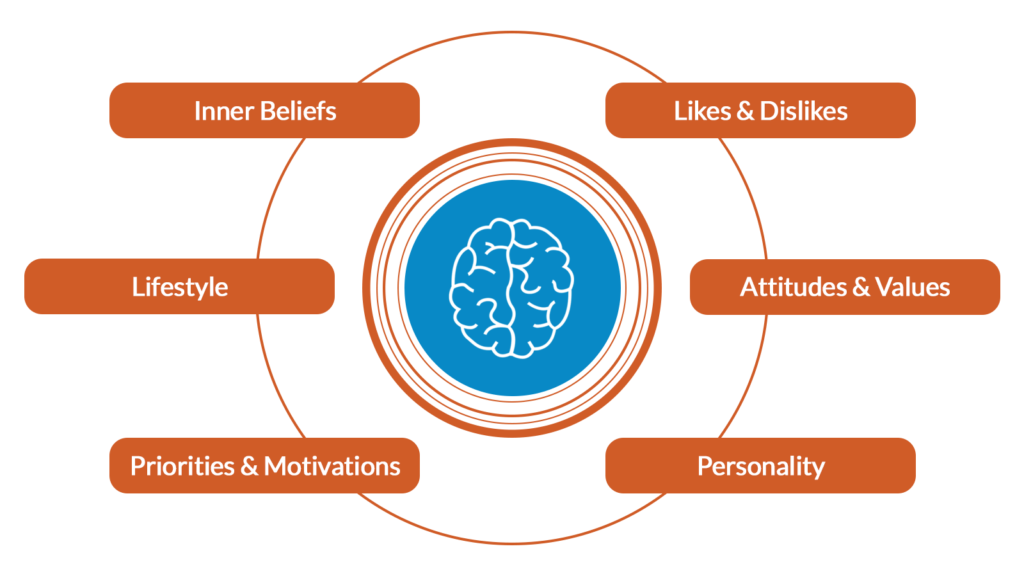
This type of audience segmentation studies peoples’ inner characteristics — traits you can’t know from studying their external behavior. In psychographic segmentation, you study characteristics like your customers’ values, attitudes, likes, dislikes, beliefs, and priorities.
Psychographic market segmentation might be tricky, but it’s also deeply valuable. After all, what’s more valuable to a marketer than knowing customers on an emotional, personal level?
Think about giving gifts to your friends and family: it’s easiest to gift when you know a person inside and out. It’s hardest when you know them tangentially and aren’t quite sure how they’d react to a gift.
In marketing, psychographic segmentation enables brands to reach their customers’ deepest thoughts and feelings and use that information to give them the best version of your brand and its products.

Attitudes and values
It pays to know what types of values people hold dear, and what attitudes they have toward different aspects of life.
If, for example, you’re a school supplies company that aims to sell to homeschoolers or the ever-growing crowd of unschooling parents, you need to understand their attitudes. An advertisement that shows a back-to-school scene complete with lockers, backpacks, and whiteboards won’t appeal to homeschooling parents. Send an ad like that to parents who have negative attitudes toward formal school and you’ll waste your money.
Likes and dislikes
With a quick and easy survey, you can find out what your audience members’ likes and dislikes are. If your company has a Facebook page or Twitter account, you can browse your followers’ accounts and see what likes and dislikes they share with the public.
Twitter will often tell you what types of things people don’t like, while Facebook has a whole section of each person’s profile dedicated to displaying their various ‘likes’: organizations, books, movies, restaurants, and so on.
While gathering this information may be time-consuming, it’s worth knowing which of your customers like (and dislike) similar things. If you’re a health and fitness company, you could send out a survey that includes a question like this:
- On a Sunday afternoon, I’m most likely to hit up the…
- Spa, because relaxation is important to my health!
- Gym. I never miss a workout!
- Hiking trail. There’s no better gym than the Great Outdoors.
Group respondents according to what they chose — 1, 2, or 3. Then, tailor your product campaigns accordingly! Knowing what types of activities your target audience enjoys can make you confident in creating advertisements that will earn you conversions.
Priorities and motivations
Why does your customer go to work every day — to support her family or to earn money for amazing trips to other countries? Even if you’re not a travel or work-related company, it’s important to know what motivates your customer.
If they’re family-oriented, an advertisement promising that your product will give them more family time will be of more value to them (and you) than an advertisement that’s open-ended. You don’t want to promote your product or service as an additional thing they have to leave home to get.
Say you are a travel company. Because you’ve implemented psychographic segmentation and know your target audience, you target your family-oriented audience with an advertisement showing a family frolicking in foamy waves. You send a different advertisement to the women in your audience who love to travel with friends. In that ad, you feature the same beach. But this time it’s at sunset, and the women are clinking wineglasses and laughing together.
Knowing where your audience’s interests lie is crucial to your success.
Personality
Is your customer logical, reasonable, and preternaturally calm? Or do they weep at those sentimental beer commercials? Maybe they love a good joke instead.
Different personalities will respond to campaigns in different ways. You can appeal to your emotions-based audience members with campaigns that tug on their heart-strings. For your humor-loving customers, make every ad Superbowl-commercial funny (or funnier!) Those that love logic and reason will need as many facts and statistics as possible in ads targeted at them; they want information and proof, not jokes.
Know your target audience’s personalities and segment them according to the similarities. Then you’ll be ready for all sorts of people to get interested in your brand.
Lifestyle
You’ve heard it before: the phrase “live within your means.” This means to not spend more money than you have, but also to enjoy what you do buy within your range of guilt-free spending.
A means is, essentially, a lifestyle: the way your audience members spend their time and money on a variety of products, services, and activities.
For psychographic lifestyle segmentation, you need to know your audience’s varying lifestyles. For example, there will be those in your audience who identify with a working-class community and mindset. They’re less likely to spend on daily luxuries and more likely to save up for something big and meaningful. Then there will be those on the social ladder who consider weekly pedicures and facials essential to their wellbeing.
You can make your brand inviting to everyone, as long as you’ve segmented your audience’s lifestyles and adjust your campaigns to suit each different group.
4. Behavioural Segmentation:
When companies divide the market based on the customer behaviour or usage patterns, it is known as behavioral segmentation. This type of market segmentation considers the past behaviour of consumers.
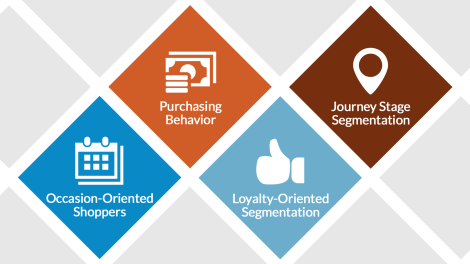
In behavioral segmentation, marketers study their customers’ decisions and online buying behaviors. Common behavioral characteristics include
- shoppers who purchase for special occasions.
- customers who seek certain benefits from their purchases, such as confidence or convenience.
- customers who purchase out of loyalty to a brand.
Because you don’t know this yet, you post about how creepy it is that Facebook can see inside your mind and actions. In the comments, some people agree with you. Others say it’s simply a marketing tactic and that all major companies do it to help show you relevant advertisements. One smart marketing friend jumps out with the exact term — behavioral segmentation. They let you know that all good marketers are using it to help keep their customers’ buying experiences relevant.
The truth is that, thankfully, Facebook can’t see inside your mind. But it can —and does — use data from cookies and IPs to track everyone’s online behavior. And like every other smart company in the world, Facebook uses behavioral segmentation. Put simply, behavioral segmentation splits an audience into segments based on similarities in purchasing behavior.
The 4 types of Behavioral characteristics in marketing
Let’s take a look at some examples of the main four types of behavioral market segmentation.
Occasion-oriented shoppers
Also known as occasion segmentation, this type of buyer segmentation can be easier to study than others. Occasion-oriented shoppers tend to buy most heavily during holidays and other special occasions.
Occasion-oriented shoppers
Also known as occasion segmentation, this type of buyer segmentation can be easier to study than others. Occasion-oriented shoppers tend to buy most heavily during holidays and other special occasions.
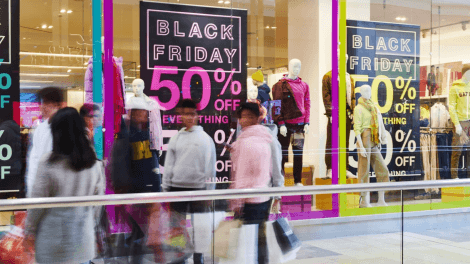
Let’s pretend we’re the company Pusheen. We sell products based on the popular cat character Pusheen and her friends. We notice that keychain sales tend to go up around Christmastime, so we study our customers to find out who purchases more keychains as Christmas gifts. Then, we put those buyers into a segment together and send them marketing emails in the days leading up to Christmas and other holidays that they’re likely to buy gifts for: Mother’s Day, for example, and even lesser-known but equally celebration-worthy holidays like National Best Friends Day. Add a sale or promo to that marketing email and your chance at securing a conversion goes up.
Your seasonal buyers can be a fantastic source of revenue if you know how to market to them.

Benefit-seeking buyers
When you go to the hair care section of your local Target, what do you look for in a shampoo?
There are dozens to choose from. But if you have curly hair, you’ll probably grab a shampoo that speaks specifically to you, the curly-haired person. Example: L’Oréal Paris’s “anti-frizz, non-drying” Ever Curl Shampoo and Conditioner.
If you have super oily hair, on the other hand, you might buy Head And Shoulders Instant Oil Control Dandruff Shampoo.
In short, benefits-based buying is when you purchase a specific shampoo based on its benefits to you. You choose the product based off the benefits that they provide you.
It’s important to take note of which of your customers buy products based on specific benefits. While this is true for any type of product, it’s especially important if you sell products and services that specifically benefit different characteristics.
Loyalty-oriented purchasing
Sometimes you’ll see a post on Instagram that says something like, “I LOVE this coffee from @bestcoffeeshopever, seriously the best I’ve tasted in my life and there isn’t even sugar in it. If you know me you know that is huge!!”

The tag doesn’t mention an advertisement, because it isn’t one. It’s someone who really, truly loves a product so much that they had to post about it on social media — and tag the company.
This is every business owner’s dream. While this hypothetical person will probably get coffee at other coffee shops sometimes, she’ll stick to @bestcoffeeshopever as much as she can because it’s her favorite. She’s a loyal customer.
It is well worth your time to find out who your loyal customers are and group them together. Known as loyalty segmentation, it’s one of the most valuable groups in your audience.
Think about how major companies reward their most loyal customers. Starbucks has a rewards program that enables frequent customers to collect stars, which earn them free drinks and meal items. Which, of course, keeps them coming back to Starbucks.
Alaska Airlines (and most airlines, for that matter) has a program where if you use its credit card, you earn frequent flyer miles — plus you get one “buy one, get one free” flight every year. Because of these two things, pretty much everyone who lives in Alaska is a loyal Alaska Airlines customer. They might even convince out-of-state family members to sign up for the Alaska card.
Happy loyal customers make perfect advocates for all types of brands. Make sure you know who your loyal customers are and create campaigns that reward them for that loyalty. Their satisfaction will keep your business strong.

Usage-oriented customers
In user status segmentation, you look at your sales and often the actions within those sales to figure out how often someone uses your product.
Example: AirBnB
Take Airbnb. The lodging-brokerage site is increasingly popular, and you can bet that the company pays attention to how often its customers make Airbnb bookings. Those customers then receive notifications about upcoming Airbnb offers

Airbnb goes a step further, offering customers the opportunity to rent out their own home while they themselves are on vacation. Airbnb’s business model has an unusual focus: co-founder Brian Chesky said in a 2016 interview with Fast Company that, “This company is first and foremost about the hosts, not the guests.”
The hosts pay a service fee for each booking they take on their properties. Guests also pay Airbnb a service fee, but it’s the hosts that find the guests. So it makes sense that Airbnb encourages its guest customers to turn into host customers. And the more a guest user books with Airbnb, the more often they are gone from their own home.
Airbnb can keep pitching the potential of making money from hosting while guest users are on vacation, likely seeing new hosts join its platform as a result.
Example: Netflix Behavioral Segmentation
In another example, Netflix saves money and keeps its customers by knowing their usage patterns. According to marketing expert Neil Patel, Netflix likely wants its users to watch a certain amount of hours of Netflix every month.

Using analytics, the company has probably figured out that a certain number of hours watched per month brings with it a higher percentage of user retention, that is, users who don’t cancel their subscription.
This drives Netflix to customize each viewer’s experience to be as relevant and interesting to that user as possible.
Because user behavior and Netflix itself are both always changing, Netflix is constantly tracking usage — time spent on Netflix, amount of pauses, fast-forwards, or re-winds, what time of day customers watch — to personalize their customers’ experience.

TARGETING
In marketing, STP marketing strategy is an important way of doing business, where its stands for market segmentation, targeting and positioning. Targeting is the processes of identifying the important target market and target audience which a company wants to sell its products to. Any product or service would not be of utility of every person. And hence companies must be focused on whom the want to target. A good targeting strategy helps a company have focused sales growth, enhanced promotional strategy, build strong customer loyalty etc. Hence, targeting strategy is the backbone for any marketing firm.
The select criteria useful for targeting in marketing are as follows:

After selection, a business/ organization that offers a wide range of products and services can decide whether to introduce a generic product (as in mass marketing) or launch different products for different segments (as in multi-segment marketing) based on the market segment’s needs and behavior.
Types of Targeting Strategies in Marketing
Some of the important targeting types used by a marketer in marketing are as follows:
1. Niche/ Concentrated marketing: Sometimes there could be very small but highly profitable market segment which cannot accommodate more than a few players. A company may choose to operate in such a well-defined group of customers by targeting them. The idea is to gain expertise in meeting the highly specialized customer needs. For example, Sensodyne is a toothpaste for consumers with sensitive teeth. The consumer segment is small but has very specific requirements.
2. Mass/undifferentiated marketing: The idea is to sell the same generic product to all consumers. Such an idea assumes that the consumers have similar needs with respect to the particular product category and hence targeting is done to a larger customer base. The main advantage is low cost as a result of economies of scale. For example, Tata iodized salt.
3. Selective/ differentiated marketing: A company may opt to provide different offerings to different consumer segments. A company can differentiate its product through the following ways to have focused targeting:
- Product differentiation (features, durability, performance, style) e.g. Apple iPhone 5 & 5c
- Services differentiation e.g. Kingfisher Airlines’ in-flight services
- Personnel differentiation e.g. Customer service at Pizza Hut
- Image differentiation e.g. Zara (fast fashion, trendy)
Advantages of Targeting Strategy in Marketing
Targeting the right set of customers is critical for any business. Some of the important advantages of targeting in marketing are:
- Targeting helps a company to use its resources wisely.
- It helps in ensuring a strong focus towards the right set of customers.
- Targeting strategy in marketing gives the employees a sense of direction where they can channelize their energies.
- It helps how customers look at its brand when compared to competitors.
- Targeting helps companies avoid redundant costs on customers who would not be a target audience for the product or service.
POSITIONING
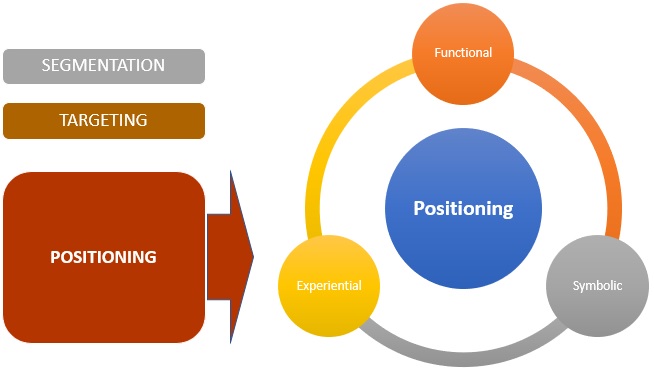
Positioning is a marketing concept followed by marketers to generate an image of their product/service in the mind of customers.
Positioning helps to create a distinct image of the brand and the product in the mind of the consumers in comparison with other products or brands. Every marketer considers the brand positioning as one of the most important aspect of overall brand creation. People have different perception about a brand based on how the brand was positioned in the market.
Importance of Positioning
In marketing, the positioning concept is followed after the market segmentation where the market is broken down and a target group for their product is identified using targeting strategy, which is collectively known as STP marketing strategy. After selecting a niche market, it helps to create an impression in the customers mind. Companies create a positioning statement for their brand, product or service which helps customers identify with the business.

Positioning is broadly classified into three types:
1. Functional: This is used when the brand or products provide solutions to problems and provide benefits to customers. It focuses on the function, benefit or utility that it gives to the customer.
2. Symbolic: This is useful for creating a brand image which helps create brand equity, a sense of social belongingness and ego-identification. It is when a customer has an affection, social connection, ego identification etc with the product.
3. Experiential: This creates sensory and cognitive simulation in the minds of the customer. It is one of the basis of the experiences which a customer can relate to.
Companies use a positioning process, which is step-wise method to place the product or service in the right way in the consumer’s mind. If a company decides to change the way people perceive a brand, then they revamp the logo, slogan etc of that brand. This process is known as repositioning of the brand, which helps create a different image of the brand.
Key Elements of Positioning Strategy
Positioning is critical for any brand, product or service to ensure an impression is created on the mind of the consumer. The main elements considered by a marketer for creating a strategy for a brand or product are:
- Product Features: Positioning can be done on how the product looks, feels, appears etc.
Utility & Benefits: It takes into account the value which a product gives and which needs are solved.
Use Categories: This defines how the product can be used.
Occasion: The time, event or the occasion when the product can be used.
Competitive Comparison: Positioning an be done when compared to a competitive offering.
In positioning the product is differentiated based on 2 things to achieve competitive advantage: –
Points of Parity (POPs): The positioning is done on the basis of mostly similar elements compared to a competitor.
Points of Difference (PODs): In this case, there is a clear difference in the product offerings vis-à-vis the competitor.
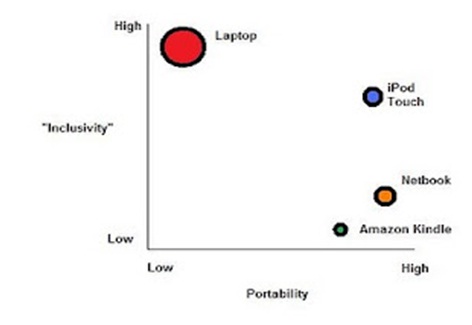
The product positioning graph for laptop, i-pod, netbook and kindle shows the benefits in terms of different parameters. This method of understanding positioning is also known as perceptual mapping or brand mapping.
Examples of Positioning
Positioning examples of products can be understood on the basis of various parameters, characteristics and features of products & services. Some key examples are:
- Aspirational: Nike (Just Do It).
- Emotional: Coca Cola (Open Happiness).
- Price-Based: Rolls Royce (Trusted to Deliver Excellence).
- Problem Solution: Head & Shoulders shampoo (Dandruff free hair).
- Benefits: Colgate (Prevents cavity and fresh breath).
RESUME STP-MARKETING

1Marketers start by dividing into segments
2 Next step is to identify the segment with opportunities as target market
3 The firm develop market offerings that is positions in the minds of the target buyers as delivering some central benefit(s).
